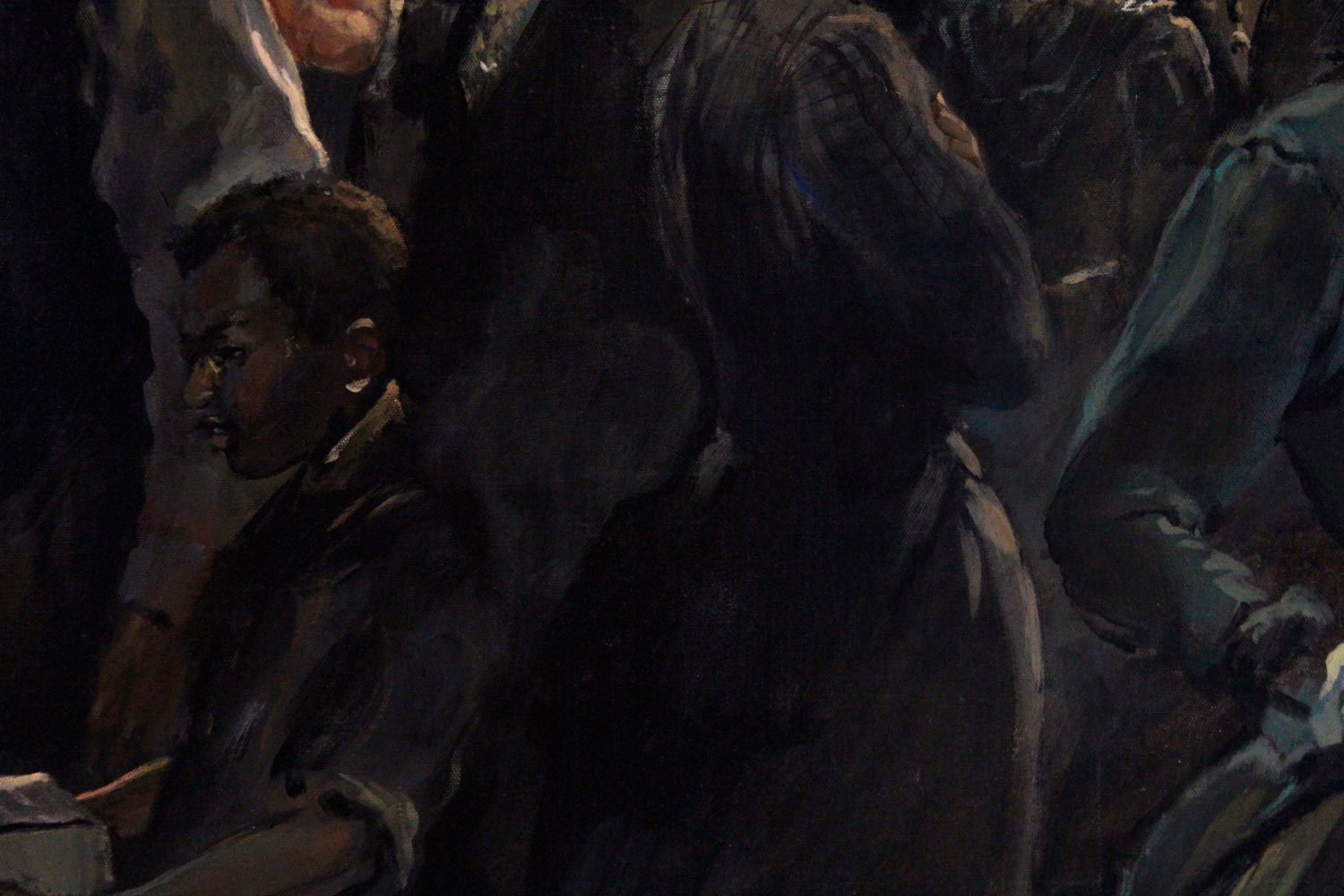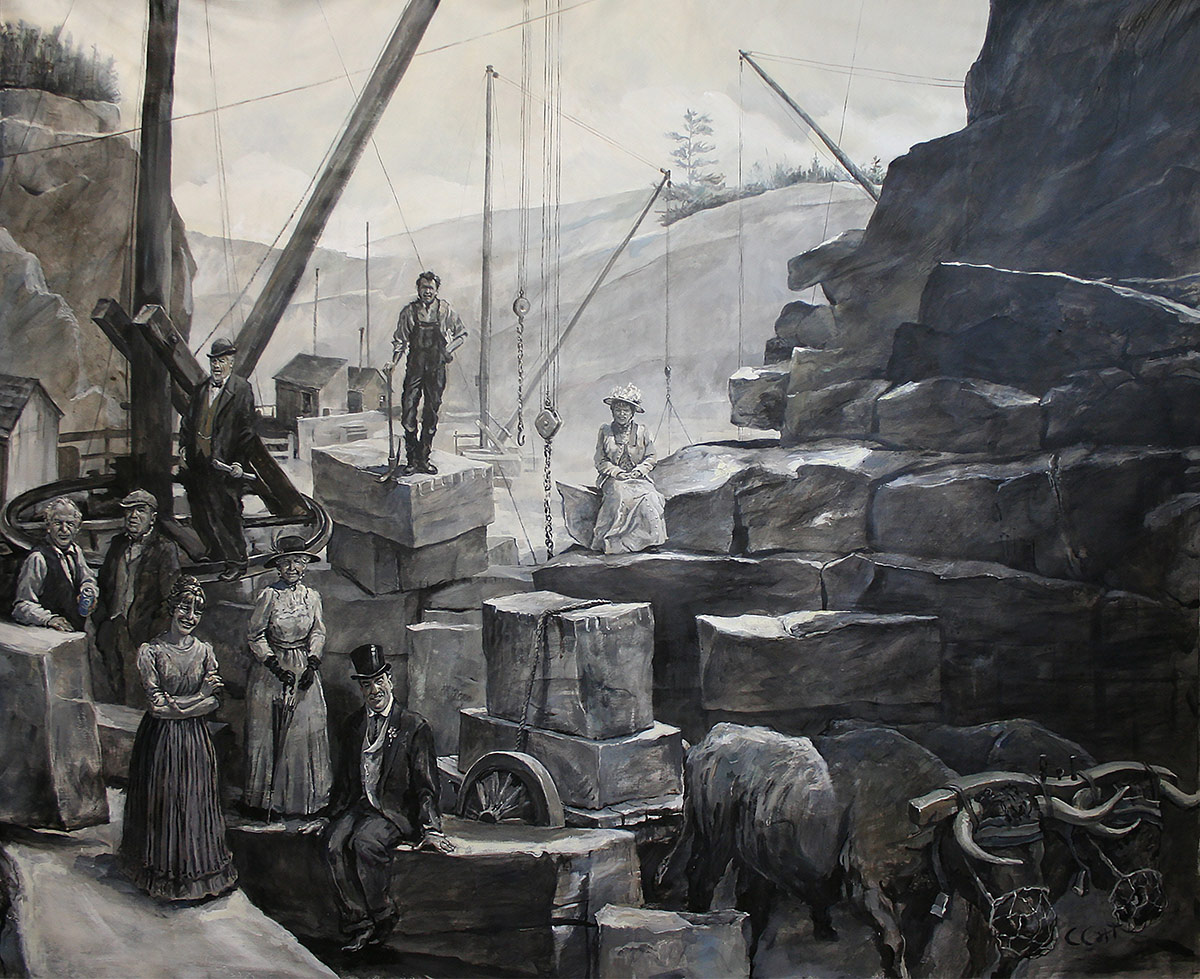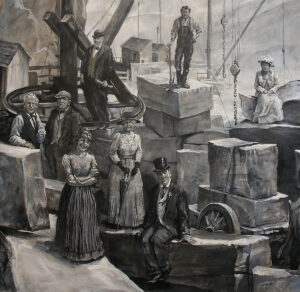Your cart is currently empty!
Category: StudioJournal
-

Work in Progress
Here is a detail from a work in progress—an oil called At the Villa Paradiso (edit: the painting is finished now, Villa Paradiso). Some paintings slam into me, fully fleshed out and only needing to be “transcribed’ to the canvas, so to speak. Others evolve over time. This one has been evolving for several years.
This detail is only a small 8 inch portion of a 32 x 40 canvas.
Some artists manage to lock onto a certain signature style and can paint that way for the rest of their days. This just doesn’t seem to work for me. My mind wants to try all sorts of things. I pursue things for a while and then just don’t like being locked in, confined.
This painting is evolving through several phases. I have been taking photos all along and when and if it is finally complete I will post a series of photos to show the route it took.
-

Art Now
[vc_row][vc_column][vc_column_text]
In his video arguing against modern art Robert Floczak’s selections of both 20th century art and previous periods of art are well, very selective, extraordinarily biased. Anyone who has studied art in any depth beyond a couple of survey books of great masters knows that there has been tons of crap created in any period, and great works as well. If you pick good examples of one and bad examples of another your are making a false argument. And it frankly, just cheapens what could be an interesting debate.Second point is that his view of “good art” leaves out creations from any period or culture except western European art from Renaissance through the late 19th century academy. Where is asian art and its gorgeous but non western use of perspective, composition and anatomy? Where are the fabulous forms created in African sculpture? What about the highly refined art of the Northwest American tribes? Where does medieval/gothic art fall into his narrow little Art alley? By his definition the great art in any 11th century cathedral is not worthy…we might just as well bull doze it, like the extremists do in the middle east.The third point is that if you remove the 20th century from the realm of great art, for starters you lose all the wonderful advances in composition and color use. If he has eyes to see he should have at least included those elements from the 20th century if he can’t stomach art that isn’t rendered to the last pore.I would be the first to admit that many great skills and pools of knowledge were shelved when the academy art techniques were subordinated…but this doesn’t mean that we should now return to the 19th century. But rather we should open our eyes and use everything at hand. I don’t fit in the 19th century, I don’t want to quote greco roman art in my paintings. I don’t wish to paint people in togas. I like the 21st century.If in his view art was a progression over several centuries to its highest pinacle in the late 19th century academy, then that leaves us poor slobs today merely copyists of era gone by.Well, to hell with that. The definition of creativity is not simply to copy. Did rembrandt copy, Did Caravaggio copy? No, they created new…that’s why we like them. Let’s revisit the skills of former eras if we so choose, but make them our own. This is what the high Itallian renaissaance did revisiting greco roman art. The skills are similar but we would not be likely to confuse a Michaelanglo with a Phidias.If Ralph Waldo Emerson is not too avant garde for this Florczak fellow then I would suggest we follow Emerson’s idea that each new generation of art needs to be created anew and judged, not as compared to high dusty ideals of old but but rather judged today, by us, those who live now. But don’t lock me into a 19th century parlor.[/vc_column_text][/vc_column][/vc_row]
-

Mother and children, Kennebec Mural
Detail from Kennebec Courthouse Mural, 2015
a Revolutionary period woman and her family, tending the garden and waiting for her husband to return from sea.
-

logging on the Kennebec, mural detail
Logging was very important on the Kennebec river up until the 1960’s.
-

voyageur, detail, Kennebec Mural
No mural of the Kennebec river history could be complete without reference to the trappers who explored the river and hills. I had drawn out the composition and the pose for this main figure in this panel, but I didn’t yet have a face I liked for him. While at the courthouse working on the mural, this man, one of the building painters came by. My wife Jen spotted him and said, “what about him?” Perfect! He was a great model, getting right into the drama and quiet action of the scene. Wonderful. Thank you.
From that point on many people associated with the new Courthouse building became part of the mural…construction workers, attorneys, their kids, the architect, even a couple of the Justices.
-
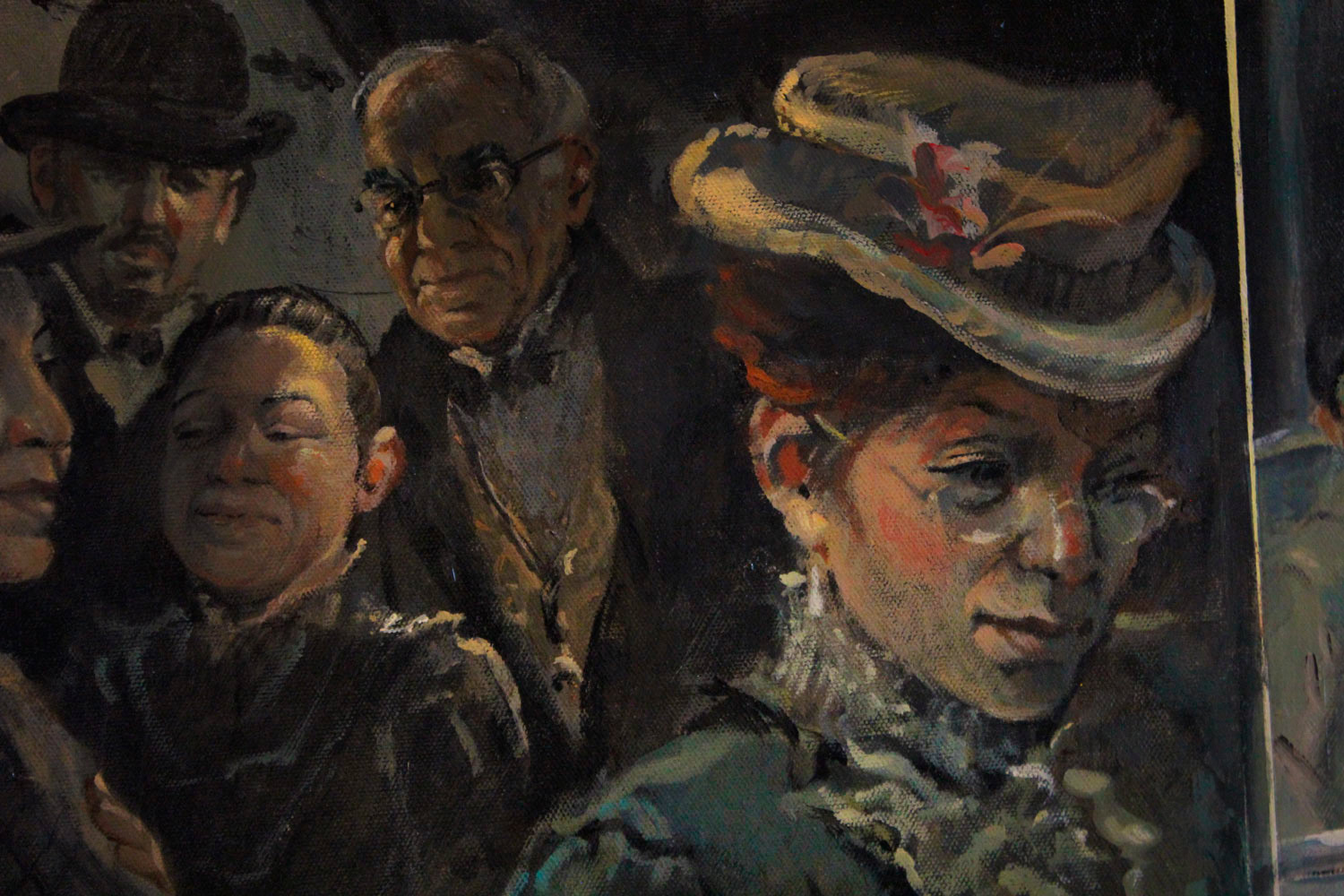
wharf crowd, detail, circa 1890, Kennebec Mural
just another detail of my Kennebec mural in Augusta, Maine. the mural is 14 x 40 feet, over 500 square feet with over 50 figures, ships, animls, period tools…a lot of life. the brushwork is quick not laboring over each pore. Love working big.
This section, the dark wharf overshadowed by the bows and rigging of many ships, I painted dark first and pulled the figures from the dark with muted midtones and a few punched highlights.
-

Granite industry, detail, Kennebec mural
The granite industry was very important for this region Maine. Stone cut from Hallowell hills was renowned for its clarity, lightness in color and its relative ease of carving. The cut stone was shipped down river by sail or on the rail road. The towers of the Brooklun bridge were build from Hallowell granite, as was the Faith statue in Plymouth and the New York Surrogate Court Hall of records building. (See more here)
-

crowded wharf, detail, Kennebec Mural
Here is a detail from my Kennebec mural. This region was a bustling river highway back in the days fo sail and this panel portrays the crowded piers in the various towns and cities along the shores. One historian wrote of Gardiner, Maine that some days the waterfront was so full of ships tied up to piers and rafted to each other that you could walk across teh river from deck to deck.
My cat, a wannabe wharf cat, made it into this section.
-

Eastman Johnson
 Out on a walk and I just found out that Eastman Johnson lived just over a mile from here on Winthrop Street in Augusta. I love knowing this. He was a fabulous artist and to know he was was at his easel just down the road is wonderful.
Out on a walk and I just found out that Eastman Johnson lived just over a mile from here on Winthrop Street in Augusta. I love knowing this. He was a fabulous artist and to know he was was at his easel just down the road is wonderful.From Wikipedia:
Eastman Johnson (July 29, 1824 – April 5, 1906) was an American painter and co-founder of the Metropolitan Museum of Art, New York City, with his name inscribed at its entrance. He was best known for his genre paintings, paintings of scenes from everyday life, and his portraits both of everyday people and prominent Americans such as Abraham Lincoln, Nathaniel Hawthorne, Ralph Waldo Emerson, and Henry Wadsworth Longfellow. His later works often show the influence of the 17th-century Dutch masters, whom he studied in The Hague in the 1850s; he was known as The American Rembrandt in his day.
-

woman on pier, detail, Kennebec Mural
a detail from my Kennebec Courthouse mural…a woman waiting to get on the steamboat pier.
-

Paint what you see.
As artists we paint what we see. In the visual arts this, of course, makes sense. But we see things many different ways and my art comes from the various things and ways I see. I remember being told the old art adage, ” Paint what you know.” And this makes powerful sense. Creation of Art is such an intense thing, pulling something from nothing. This is not easy, if done well. If you paint things you don’t know intimately then you run the serious risk of painting only superficial art, postcards from travels to places we don’t understand. You have to look and look and learn and learn to know something inside and out, to paint it well. Not to capture the surface detail. Hell, getting a likeness, of a tree or a house or a person, that is basic, easy, Art School stuff. Surface likeness is shallow, just basic art rendering. But it is telling something important about the thing that is the challenge. The challenge that keeps expanding if you let it.
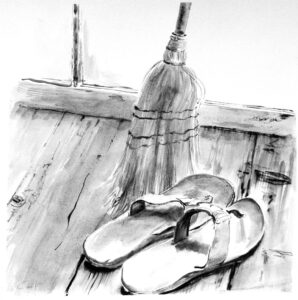 So being told to paint what I know when I was young was terrifying. I was young. I was dumb. I didn’t know anything so how could I paint? But then it dawned that it didn’t mean I couldn’t learn more, know more, draw more.
So being told to paint what I know when I was young was terrifying. I was young. I was dumb. I didn’t know anything so how could I paint? But then it dawned that it didn’t mean I couldn’t learn more, know more, draw more.So really painting is not about art but about jumping in and EXPERIENCING. This is the route to having something to paint, knowing more. Just go and dance. This is assuming that as an artist you want to paint something powerful, something with vision, something strong. And a powerful painting can be many things…it can be a huge dramatic painting condemming war, or a small simple glance of sunlight on the edge of a summer bouquet. It is not what you paint but how well you have seen and how you paint it.
To paint something you need to know it, learn it, study it. Draw it so many ways that you can move it around in your head to fit any angle, any life you want to give it. The more you look, the more you see.
Often I pose models but they are posed to fit the vision I already have in my head. I see the figures inside first, sketch them out and then find models and poses to flesh them out.
Which brings me back to what I first meant. We paint what we see. Sometimes that is what is in front of our noses right now. Sometimes the seeing is in our heads and the “vision” is made flesh on canvas with our paint. And often paintings are a mysterious combination of the two…and who knows what else. Often in my work, things from many years ago, things I saw, people I drew, ideas I had, inform and merge into current paintings to bring a reality to new paintings. Old joining with new to make a painting. And as I walk down a street I may see a twirl of hair by someone’s ear that suddenty fits well into my current painting or a thought bubbles up from years ago and seems to fit into now. My paintings may look like moments but they are more like woven stories from many days.
So paint what you see, paint what you know, but never stop knowing and seeing more. The more you look, the more you will see. The more you see, the more you will understand and take into your core. And then, just maybe, with perserverance, we will paint well. It only ends when we stop seeing.
-

Sleeping Woman
ink on Arches watercolor hot pressed paper, 8 x 10 inches
There is something about playing with simple lines on white paper.
-
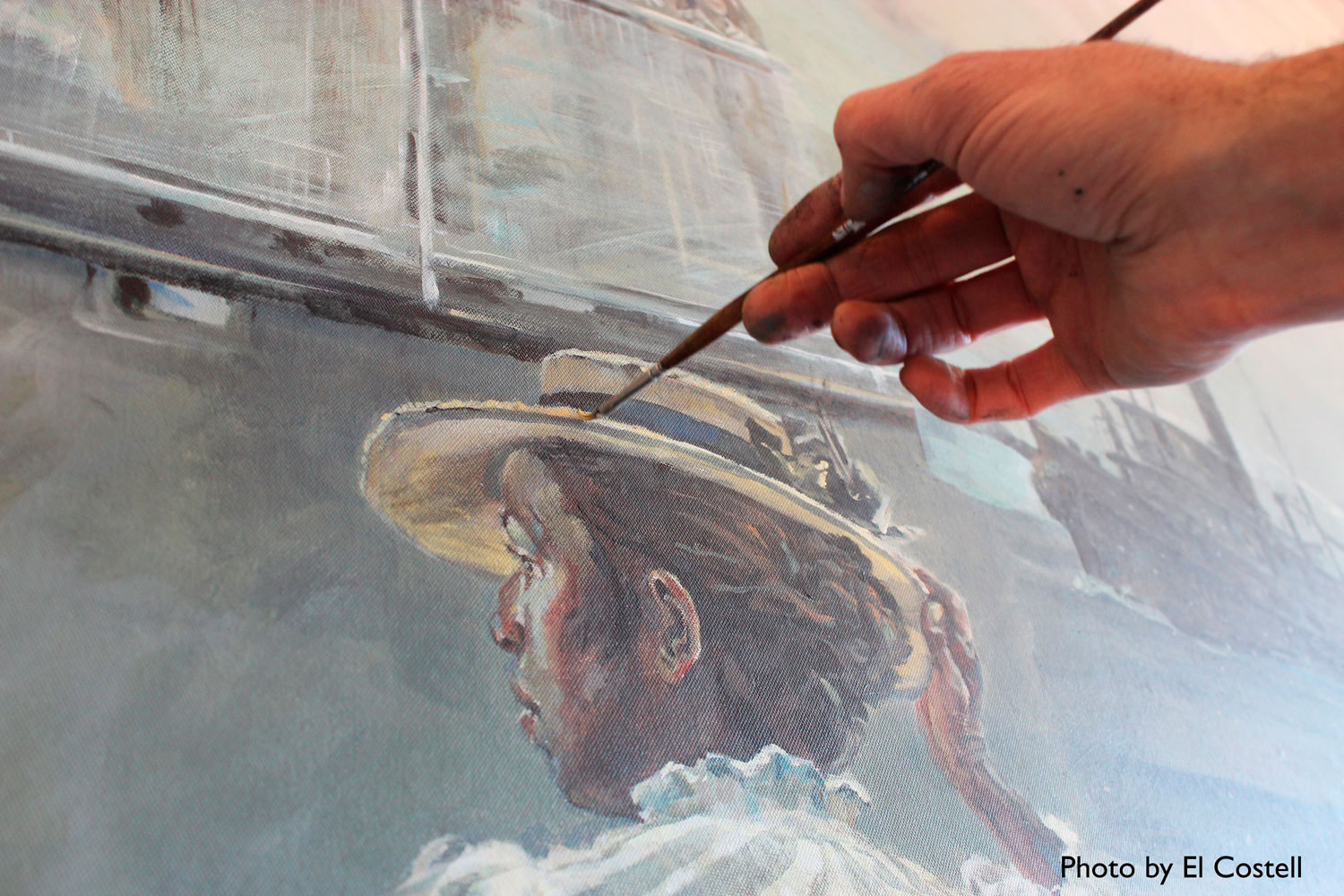
Kennebec Mural, finished
[vc_row css_animation=”” row_type=”row” use_row_as_full_screen_section=”no” type=”full_width” angled_section=”no” text_align=”left” background_image_as_pattern=”without_pattern”][vc_column width=”2/3″][vc_column_text]My new mural at the Kennebec County Superior Court in Augusta, Maine is now complete. You can see a portfolio of detail images here: Kennebec Mural. Just started adding images, many more to come.
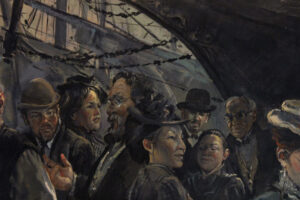 Kennebec celebrates the river as road, home and workplace to the generations of ordinary people who traveled, traded and lived on the river. Within the forty foot mural five hundred years and 12 time periods coexist under the same eternal sky. As the river continues constant and unchanging, Christopher Cart paints the human story from Native American canoe to sailing ships to steamships.
Kennebec celebrates the river as road, home and workplace to the generations of ordinary people who traveled, traded and lived on the river. Within the forty foot mural five hundred years and 12 time periods coexist under the same eternal sky. As the river continues constant and unchanging, Christopher Cart paints the human story from Native American canoe to sailing ships to steamships.The mural depicts ice cutting, logging, sailing ships and ship building, early Popham explorers and Abnakis, leisure days and travel and the hard work of the people who tended the land while raising families. This important shipbuilding river valley launched 4000 ships over the years, so it was a bustling, vital place of importance. The Kennebec river was a major highway to the world and seamen from this region could find fellow Kennebec valley men in any major port of the world.
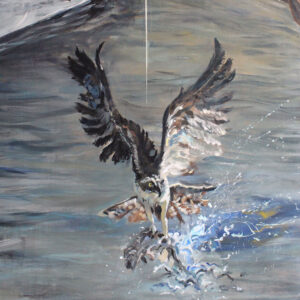 Months of research were necessary for Cart to accurately portray proper period clothing, tools, ships and details from 500 years of life on the river. Particularly helpful was the vast image reference library at the Maine Maritime Museum in Bath. After the research, came the drawing of hundreds upon hundreds of “studies” of clothing, figure poses, tools and settings, to refine the details and the overall composition of the piece.
Months of research were necessary for Cart to accurately portray proper period clothing, tools, ships and details from 500 years of life on the river. Particularly helpful was the vast image reference library at the Maine Maritime Museum in Bath. After the research, came the drawing of hundreds upon hundreds of “studies” of clothing, figure poses, tools and settings, to refine the details and the overall composition of the piece.When plans were complete, the blank, primed mural canvas was applied to the wall in the Courthouse using 3 gallons of glue. Next the painting of the actual mural began with a scrubbed in underpainting. Cart’s detailed half size final drawings were then transferred to the canvas in charcoal using a traditional grid method to enlarge them. The mural was painted in archival acrylic paint mostly with one and two inch brushes. It is covered with a clear isolation barrier acrylic and three coats of final varnish.
Over fifty figures populate the mural, from a hardworking pregnant colonial wife to sailors aloft in the rigging. As a point of interest, many people connected with the Courthouse building posed as models for the mural, including several Justices, the building architect, construction foremen and workers.
Kennebec honors the men and women who came before us. They are no more, but their legacy endures.[/vc_column_text][/vc_column][vc_column width=”1/3″][vc_column_text]
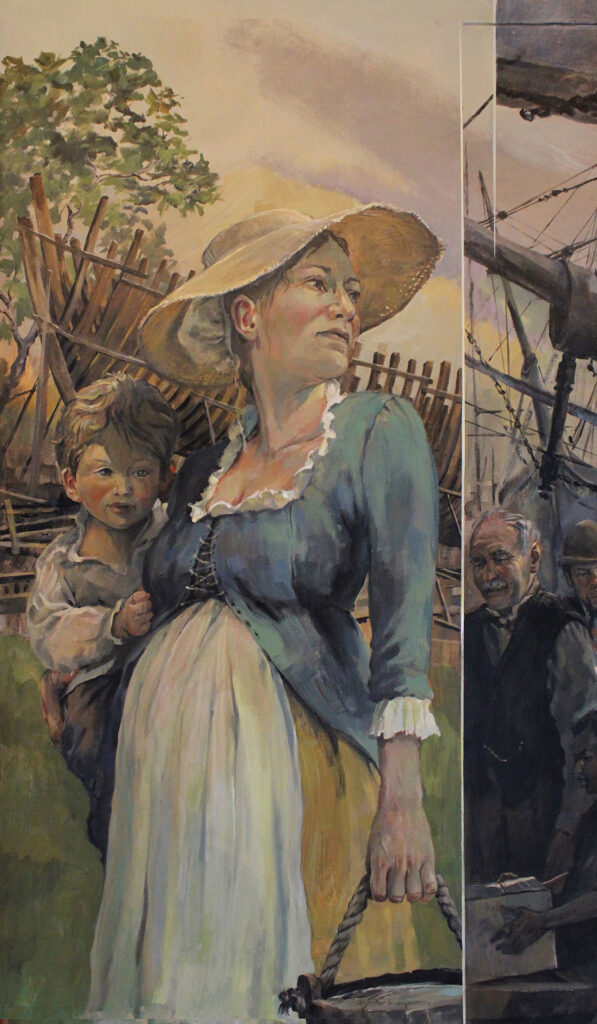
detail: colonial mother and child
Kennebec, by Christopher Cart
14 x 39 foot mural, acrylic on primed canvas applied to wall
Kennebec Count Superior Court, 2nd Floor,1 Court Street, Suite 101, Augusta, ME 04330
Completed February 2015[/vc_column_text][/vc_column][/vc_row][vc_row css_animation=”” row_type=”row” use_row_as_full_screen_section=”no” type=”full_width” angled_section=”no” text_align=”left” background_image_as_pattern=”without_pattern”][vc_column][/vc_column][/vc_row] -

Courthouse mural progress
The Kennebec County Courthouse mural is progressing swiftly. About two and a half weeks of actual work on the wall…following months of research and studies…and the mural is flying along. 12 hour days with brushes will do the trick.
 Here my seamen in the rigging are going in well above the doorway. Couldn’t work on them most of last week as they were moving in office equipment into the adjoining rooms and needed this doorway. For some reason they didn’t want me hanging around on a ladder right in that doorway.
Here my seamen in the rigging are going in well above the doorway. Couldn’t work on them most of last week as they were moving in office equipment into the adjoining rooms and needed this doorway. For some reason they didn’t want me hanging around on a ladder right in that doorway.The middle seaman is looking a bit more piratical than I intended. He looked good on the sketch pad but up on the wall, larger than life, he is a bit too swarthy. So I will give him a shave on Monday.
Here are a couple of dock workers just started in one section. Happy with the light coming in, peeling things out of the shadows. (the grid is from the initial enlargement from the studio rendering.)
 and a few more figures on the busy dock…these obviously show early stages but I like the energy at this point. These early stages of paint have to have the right life, spirit. If these stages are dead then no amount of polish and detail will hold a chance of resuscitation.
and a few more figures on the busy dock…these obviously show early stages but I like the energy at this point. These early stages of paint have to have the right life, spirit. If these stages are dead then no amount of polish and detail will hold a chance of resuscitation. -

Logger from the Courthouse mural, part 2
 Today working on the Kennebec Courthouse mural I did the initial block in of the logger. I enlarged and transferred the drawing to the wall with the traditional grid method…drawing a grid on the drawing and then drawing a larger grid on the wall and using the grid to reference where the parts of the drawing go. I have been drawing the larger grid on the wall with light colored pencil and then just drawing the figures in charcoal. Then I proceed to the block in of the paint.
Today working on the Kennebec Courthouse mural I did the initial block in of the logger. I enlarged and transferred the drawing to the wall with the traditional grid method…drawing a grid on the drawing and then drawing a larger grid on the wall and using the grid to reference where the parts of the drawing go. I have been drawing the larger grid on the wall with light colored pencil and then just drawing the figures in charcoal. Then I proceed to the block in of the paint.Also worked on trees, ship rigging, an 18th century musket and some mist today. A good day of brushes. I am not the tidiest of painters but I like the feeling of planning very well up front with drawings and studies and then working loose on the final canvas…pulling things from seeming chaos. Rough scrub-ins give much more energy underlying the final paint.
-

Logger for Courthouse Mural
 For my Kennebec County Courthouse mural I have been finding models all over the place. After lots of research about logging in Maine I had narrowed down the type of pose I wanted. This taught me the tools and how they were used. How the men moved and pried logs, and maneuvered logs in various currents. So I worked up a dynamic posed I liked but then I needed a model.
For my Kennebec County Courthouse mural I have been finding models all over the place. After lots of research about logging in Maine I had narrowed down the type of pose I wanted. This taught me the tools and how they were used. How the men moved and pried logs, and maneuvered logs in various currents. So I worked up a dynamic posed I liked but then I needed a model.Then doing a bit of shopping in the grocery store I found him. A great guy, a great face, and a good model who fell right into the right pose. This is a man who has done a lot of outdoor work and it makes a difference in the posing. People who have done physical labor can pose much more naturally than trying to pose someone in a more sedentary job.
Here is an interesting old film about logging I found on youtube. From stump to ship: A 1930 logging film
-

Mural research at the Maine Maritime Museum
 Yesterday I spent the day at Maine Maritime Museum in Bath, Maine, doing mural research in the photo library. It was a fascinating day looking through hundreds of vintage photographs. This kind of research is enjoyable but is also essential for this type of mural.
Yesterday I spent the day at Maine Maritime Museum in Bath, Maine, doing mural research in the photo library. It was a fascinating day looking through hundreds of vintage photographs. This kind of research is enjoyable but is also essential for this type of mural.I need to make sure that I am getting details historically accurate. What does a schooner shipyard of the time look like. What kind of jobs are going on. All this is very important. To the right is a nice clear photo of the tugboat the Seguin. This tug was built in 1884 and towed schooners down the river for many decades. I needed a clear image of its structure so I can find how to draw it for the mural. With a clear enough series of photos I can ‘learn’ the ship and then draw it from any angle I need.
There is another aspect that, as a painter, and a story telling painter, that I find very important.
While some photos are of important events in history, a lot of the type of photos I learned from yesterday were the snapshots of the day. Just someone with a camera. In these I often look at the main event but I can also find out essential story telling details by looking a tiny corners of the photos. Someone bending to pick up a tool. A woman with a basket of bread. Little things that take time to see and decipher but that will flesh out the daily lives of the people I am trying to portray.
While posed photos of famous people may tell me what that person looked like. Other photos will tell me how people lived, worked and played.


